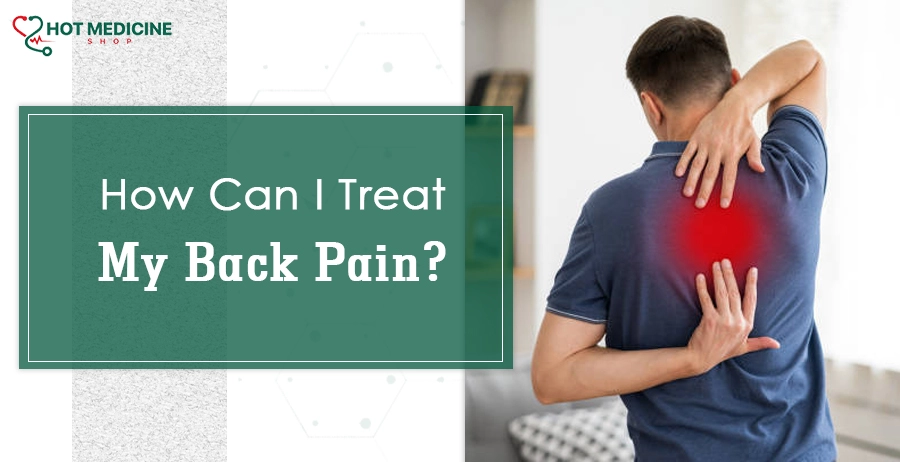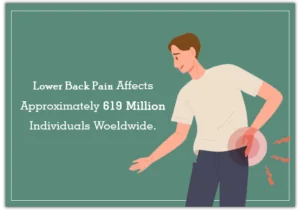How Can I Treat My Back Pain?

Back pain is The most common ailment affecting people across a wide range of ages and backgrounds. It does not matter how long you sit at your desk, how physically demanding your activities may be, or how old you may be; back pain can be an unwelcome companion.
We must understand the causes and types of back pain to provide effective pain treatment. This comprehensive guide aims to provide you with a comprehensive understanding of back pain. If you have a question “How Can I Treat My Back Pain?” Then here you will know the most effective treatments to help you feel better and regain control of your life.
😫 What Is Back Pain?
A common affliction of individuals of all ages, backgrounds, and lifestyles is back pain, which can affect individuals from all walks of life. It is characterized by discomfort or pain in the back region, extending from the neck to the 😮 lower back pain.

Our spines are a complex structure consisting of bones, muscles, ligaments, and discs that play an integral role in our daily lives. If any of these intricate systems are disrupted, the result can be various degrees of back pain.
There are many causes of back pain. These include muscle strains, ligament sprains, herniated discs, spinal stenosis, arthritis, and poor posture. To treat effectively, it is crucial to understand the underlying cause. In addition to mild, intermittent discomfort, it can manifest as severe and chronic pain that is significant to one’s quality of life. It is important to note that lower pain can manifest in various ways.
📝Types of Back Pain
▪ Acute Back Pain
It is well known that acute back pain is characterized by its sudden onset and tends to last for a short period, usually between a few days and a few weeks. This type of pain often results from an incident or injury that has happened, such as lifting a heavy object improperly, twisting, or falling.
It is also possible to suffer from acute caused by muscle strains, sprains, and inflammation. It may also cause muscle spasms, swelling, and stiffness, as well as tenderness and difficulty in moving the affected area, which are often accompanied by a rash of muscle spasms. Pain O Soma 350 mg provides rapid relief from muscle discomfort and tension, allowing you to resume daily activities.
▪ Chronic Back Pain
An individual suffering from chronic back pain usually suffers from it for a long period, typically over three months. In contrast, acute pain is not always caused by a clear and immediate cause. Chronic back pain can be caused by several factors, including underlying illnesses, degenerative changes in the spine, or injuries that have not yet healed.
As a result of chronic pain, daily activities, work, and general well-being can be greatly affected. A combination of medication, physical therapy, and lifestyle changes can usually be used to treat. Surgery is also an option in some cases, however.
😓Treating Chronic Back Pain
Addressing chronic back pain often requires a comprehensive and multidimensional approach. It involves understanding the specific causes of the pain and tailoring a treatment plan accordingly. While acute pain may respond to short-term interventions, chronic pain often necessitates long-term strategies. These strategies may include physical therapy, lifestyle changes, and medication. In some cases, surgery may be necessary.
🩹Treatments
▪️ Home Treatments
Maintain Good Posture: Poor posture is a common contributor to pain. Whether sitting at a desk or standing for extended periods, maintaining good posture can alleviate strain on the spine.
Exercise Regularly: Engaging in regular, low-impact exercises can strengthen the muscles supporting the spine. Walking, swimming, and yoga promote flexibility and overall spinal health.
Use Ergonomic Furniture: Investing in ergonomic chairs and desks can provide the necessary support for the back, especially during prolonged periods of sitting.
Maintain a Healthy Weight: Excess weight places additional stress on the back muscles and can contribute to back pain. Maintaining a healthy weight through a balanced diet and regular exercise is essential.
Read More About Muscle Pain
▪️ Medical Treatment
Over-the-counter Medications: Nonprescription pain medications, such as ibuprofen or acetaminophen, can help treat mild to moderate back pain by lowering inflammation and relieving pain.
Prescription Medications: For more severe cases, healthcare professionals may prescribe stronger medications to manage pain and address underlying issues contributing to back pain.
Injections: Corticosteroid injections directly into the affected area can temporarily relieve inflammation and pain, especially in cases of nerve-related back pain. Take advantage of Pain O Soma 500 to manage pain more comfortably and stress-free.
▪️ Physical Therapy
Customized Exercise Programs: Physical therapists create personalized exercise regimens to target specific muscle groups, improve flexibility, and alleviate pain.
Manual Therapy Techniques: Massage, mobilization, and manipulation are hands-on techniques that physical therapists use to improve joint function and reduce pain.
Education and Posture Training: Understanding proper body mechanics and ergonomics is crucial in preventing future back issues. Physical therapists educate individuals on how to maintain good posture and body alignment.
❤️🩹Heat Therapy and Cold Therapy to Help Back Pain
▪️ Heat Therapy:
Applying heat, either through hot packs or warm baths, can help relax muscles, improve blood flow, and ease pain. It is particularly beneficial for muscle-related back pain.
▪️ Cold Therapy:
Cold packs or ice can be applied to reduce inflammation and numb the affected area, relieving acute pain. Cold therapy is often recommended for injuries or sudden-onset back pain.
👇Bottom Line
Effectively treating back requires a personalized and holistic approach that considers the specific causes and symptoms. While home treatments and lifestyle adjustments play a significant role, seeking professional advice is crucial for chronic or severe cases. Consulting with a healthcare provider or a specialist can help determine the most suitable treatment plan for individual needs.
Understanding the types of pain and exploring the available treatments empowers individuals to take proactive steps toward finding relief and improving overall spinal health. A comprehensive approach that combines self-care, medical intervention, and professional guidance is key to a healthier and pain-free back. Remember, managing is about alleviating symptoms and addressing the root causes of long-term well-being.
